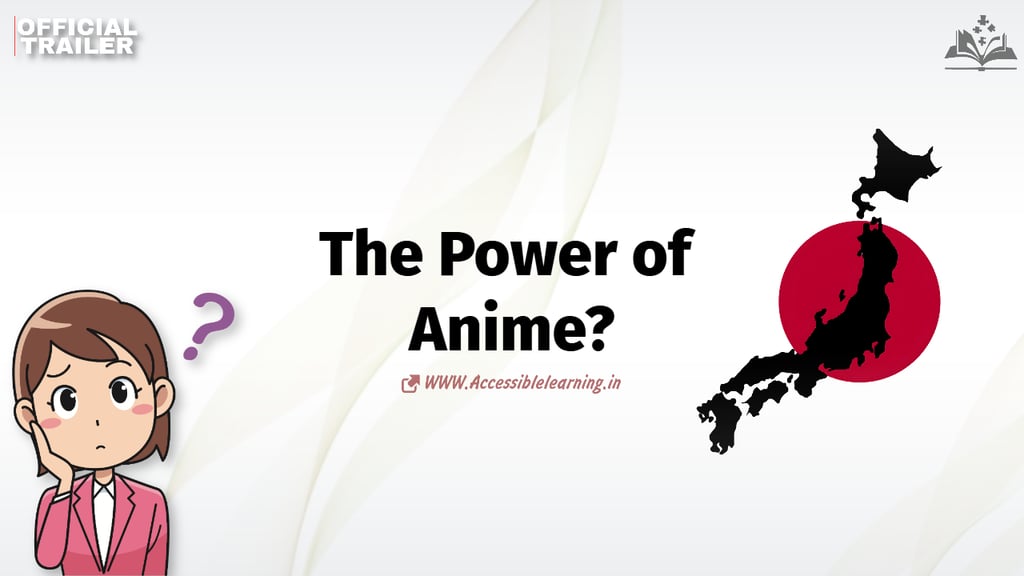
Understanding Anime’s Growing Influence on Society and Youth?
Discover the profound impact of anime on people and kids, exploring its role in fostering creativity, emotional intelligence, cultural awareness, and social connections. This in-depth analysis examines both the positive and negative effects of anime, offering insights for parents, educators, and fans alike.
ANIME INDUSTRYNEW YOUTH ISSUESCOMPANY/INDUSTRYAWARE/VIGILANTSTORY/ENTERTAINMENT
Sachin K Chaurasiya
12/16/20246 min read


Anime, a distinct form of animated storytelling that originated in Japan, has become a global phenomenon over the past few decades. With its vibrant art, compelling narratives, and diverse genres, anime has captured the hearts of millions of people worldwide, including children. But what makes anime so impactful, and how does it influence individuals and kids? This article delves into the multifaceted impact of anime on its audience, exploring its cultural, psychological, educational, and social dimensions.
The Global Appeal of Anime?
Anime transcends cultural boundaries through its ability to convey universal themes such as love, friendship, perseverance, and self-discovery. Popular series like Naruto, Dragon Ball Z, Attack on Titan, and My Hero Academia resonate with audiences due to their relatable characters and thought-provoking storylines. This universality has contributed to anime's widespread acceptance across different cultures and age groups.
For children, anime often provides an imaginative escape, introducing them to fantastical worlds, unique characters, and gripping adventures. For adults, anime can offer profound philosophical insights, moral dilemmas, and mature storytelling that rival traditional cinema and literature.
Positive Impacts of Anime!
Enhancing Creativity and Imagination?
Anime's visually stunning art styles and inventive storytelling can inspire creativity in viewers, particularly children. Shows like Pokémon and Studio Ghibli films encourage imaginative play, storytelling, and even artistic pursuits such as drawing or animation.
Promoting Emotional Intelligence
Many anime series delve deeply into the emotions and struggles of their characters. For example, Clannad and A Silent Voice explore themes of grief, forgiveness, and empathy. These narratives can help viewers, especially kids, understand and navigate complex emotions, fostering emotional intelligence.
Teaching Life Lessons
Anime often emphasizes values like resilience, teamwork, and kindness. Naruto, for instance, teaches the importance of never giving up, while One Piece highlights loyalty and the power of friendship. These lessons can shape a child’s character and worldview.
Bridging Cultural Gaps
Through anime, viewers are exposed to Japanese culture, traditions, and values. Shows like Spirited Away introduce audiences to Shinto beliefs, Japanese festivals, and folklore. This cultural education fosters greater appreciation for diversity and global understanding.
Educational Value
Some anime incorporate educational content seamlessly into their plots. Cells at Work! explains human biology in an engaging way, while Dr. Stone introduces viewers to scientific concepts and innovation. Such series can spark a love for learning in children.
Encouraging Social Connections
Anime fandoms are known for fostering a sense of community. Conventions, online forums, and fan art collaborations allow kids and adults to interact with others who share similar interests. This social engagement can help children develop communication skills and build meaningful relationships.


Negative Impacts of Anime?
While anime offers numerous benefits, it is essential to acknowledge its potential drawbacks, especially for younger viewers.
Exposure to Mature Themes
Not all anime is suitable for children. Some series, like Death Note or Attack on Titan, contain violence, psychological tension, and mature themes that may not be appropriate for younger audiences. Parents need to ensure age-appropriate content for their kids.
Addiction and Screen Time
The immersive nature of anime can lead to binge-watching, which might result in excessive screen time. This habit can interfere with academic performance, physical health, and social interactions if not moderated.
Unrealistic Expectations
Anime often portrays exaggerated physical attributes, romantic ideals, or heroic feats. For impressionable viewers, this can lead to unrealistic expectations about body image, relationships, or personal achievements.
Cultural Misinterpretations
While anime introduces viewers to Japanese culture, it might also perpetuate stereotypes or oversimplify complex traditions. For example, viewers might mistake exaggerated anime tropes for authentic Japanese behavior.
Potential for Over-Identification
Some fans, particularly children, might become overly attached to anime characters or storylines. This over-identification can lead to escapism, making it challenging for them to engage with real-world responsibilities or relationships.
The Role of Parents and Educators?
To maximize anime’s positive impact while mitigating its risks, parents and educators can take an active role in guiding children’s anime consumption.
Monitor Content: Ensure children watch age-appropriate anime by checking ratings and reviews.
Encourage Discussion: Engage in conversations about the themes and lessons in anime to foster critical thinking.
Balance Screen Time: Set limits on viewing hours to ensure a healthy balance between entertainment, study, and physical activity.
Promote Creative Activities: Encourage kids to channel their inspiration from anime into productive pursuits, such as drawing, writing, or cosplay.
Cultivate Media Literacy: Teach children to differentiate between fiction and reality, helping them critically analyze the content they consume.

Impact of Anime on Cognitive Development?
Anime often challenges viewers with intricate plots, multifaceted characters, and thought-provoking themes. This complexity can benefit cognitive development, particularly in children and teenagers.
Critical Thinking: Many anime series, such as Death Note and Steins;Gate, require viewers to follow detailed narratives, solve mysteries, or consider moral dilemmas, fostering analytical and critical thinking skills.
Problem-Solving Skills: Shows like Dr. Stone emphasize creative problem-solving and scientific reasoning, inspiring viewers to think outside the box.
Language Learning: Subtitled anime has encouraged non-Japanese-speaking audiences to pick up Japanese phrases, vocabulary, and even grammar. This exposure can enhance language acquisition and interest in multilingualism.
Anime and Mental Health?
For some, anime serves as an emotional outlet or a form of escapism during challenging times.
Coping Mechanism: Anime with themes of overcoming adversity (My Hero Academia) or finding hope in difficult circumstances (Your Lie in April) can resonate with viewers dealing with personal struggles.
Representation and Validation: Characters in anime often face mental health issues, such as depression (Welcome to the NHK) or trauma (Attack on Titan). This representation can help normalize conversations around mental health and provide a sense of validation for viewers experiencing similar emotions.

Anime's Impact on Adults?
Anime's influence isn't limited to children. For adults, it can provide emotional solace, intellectual stimulation, and a sense of community. Series like Neon Genesis Evangelion and Monster tackle existential questions and psychological complexities, encouraging viewers to reflect on their own lives. Additionally, anime conventions and online forums foster social connections among fans, creating a shared sense of belonging.
Anime also plays a significant role in career inspiration. Many artists, writers, and animators cite anime as a driving force behind their creative aspirations. Furthermore, the industry’s expansion has created new opportunities in fields like dubbing, merchandise, gaming, and content creation.
Anime’s Influence on Fashion and Lifestyle?
Cosplay Culture: Dressing up as anime characters at conventions has become a global phenomenon, fostering creativity and self-expression.
Streetwear Influence: Iconic anime like Akira have inspired high-fashion brands and streetwear labels worldwide, shaping contemporary design aesthetics.
Lifestyle Choices: Some viewers adopt aspects of Japanese culture, such as mindfulness practices or minimalist living, after being inspired by anime.
Social and Emotional Learning Through Anime?
Anime often deals with relationships, teamwork, and resilience in ways that resonate deeply with viewers:
Interpersonal Skills: Shows like Haikyuu!! and Free! emphasize the importance of teamwork, sportsmanship, and camaraderie, encouraging viewers to develop similar values in real life.
Empathy Building: Stories that highlight marginalized voices or experiences, such as March Comes in Like a Lion (about bullying and depression), promote understanding and empathy.
Anime’s Economic Impact
Merchandising: From action figures to clothing, anime merchandise is a lucrative market. Fans often collect memorabilia, driving the industry further.
Tourism: Iconic anime locations, such as those featured in Your Name or Spirited Away, attract global tourists to Japan, boosting its economy.
Content Creation: Anime has inspired countless creators worldwide to produce fan art, fan fiction, and even independent animations, contributing to a thriving creative ecosystem.
Emerging Trends in Anime Consumption!
Streaming Platforms: Services like Crunchyroll and Netflix have made anime more accessible than ever, expanding its audience globally.
Inclusivity in Anime: There’s a growing trend of anime featuring diverse characters, representing various cultures, abilities, and orientations, making it more inclusive.
Virtual Reality Anime: Innovations in VR and AR technology are paving the way for immersive anime experiences, blending storytelling with interactive entertainment.
How Educators Can Leverage Anime?
In the Classroom: Teachers can use anime like Cells at Work! or Dr. Stone to make science more engaging or employ historical anime such as Rurouni Kenshin to spark interest in history.
Workshops and Clubs: Schools and community centers can host anime-based workshops to teach art, storytelling, or even Japanese culture.

Anime’s impact on people—especially kids—is a double-edged sword. While it has the power to inspire creativity, teach valuable life lessons, and promote cultural awareness, it also requires mindful consumption to avoid potential pitfalls. By leveraging anime’s positive aspects and addressing its challenges, parents, educators, and fans can ensure that this art form continues to enrich lives across generations.
As anime’s popularity continues to grow, it will undoubtedly remain a significant cultural force, shaping the minds and hearts of its viewers for years to come. Whether it’s a child discovering the joy of storytelling or an adult finding solace in a beloved series, anime’s influence is undeniable and enduring.
And... And... And... 🙄
Anime’s ability to weave complex narratives with relatable characters ensures its continued relevance in global media. By inspiring creativity, fostering social connections, and teaching valuable lessons, anime remains a transformative force for people of all ages. However, it is equally vital to guide younger viewers toward mindful consumption, ensuring they experience the medium’s benefits while avoiding potential pitfalls.
Subscribe to our newsletter
All © Copyright reserved by Accessible-Learning
| Terms & Conditions
Knowledge is power. Learn with Us. 📚


